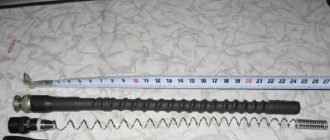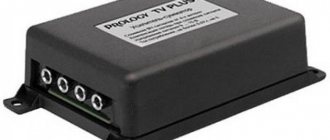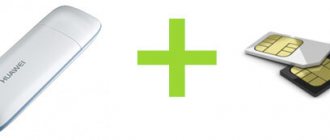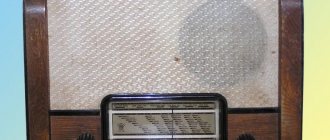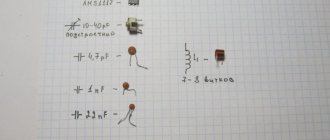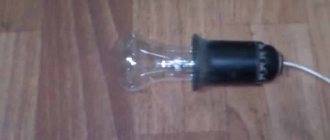FM antenna amplifier
I propose an antenna amplifier circuit for FM radio receivers.
As you know, outside the city, reception of radio stations in the FM range is extremely difficult. The signal level noticeably attenuates if there are any buildings or buildings in the path of the waves. To compensate for signal loss, it is necessary to raise the receiving antenna as high as possible, however, it is not always possible to achieve the desired result. A narrowband antenna amplifier will help to significantly change the situation for the better. This amplifier is equipped with a filter at the input, which allows it to block signals below 60 MHz and above 120 MHz, providing amplification only on the VHF band. Coils L1 and L2 are wound with PEL-2 wire with a diameter of 0.4 mm on a mandrel with a diameter of 4 mm. L1 contains 3.5 turns, L2 – 4.5 turns. The amplifier is powered by a voltage of 9-12 volts, while consuming a current of about 12 mA. Gain 18 dB. The amplifier can be wired in a metal case. Connections from the antenna to the amplifier and from the amplifier to the radio receiver are made with a shielded cable. Discuss on social networks and microblogs
Radio amateurs are interested in electrical circuits:
Please provide a circuit diagram for a medium-wave antenna amplifier.
Gray, as I understand it, you are talking about the amateur radio range of 1.8 MHz or 160 m. If so, then instead of an amplifier for the mid-wave range, try to calculate, design and use an EH antenna . According to radio amateurs, the efficiency, setup, ease of use and quality of reception and transmission of EH antennas are excellent. Moreover, using special programs, you can calculate an antenna for almost any desired frequency from a given range. An interesting fact is that the EH antenna is used underwater. Materials on EH antennas: Information: theory and practice of using EH antennas. Calculations: program for calculating EH antennas 1, program for calculating EH antennas 2
what the hell is om50 when you can make a regular frame antenna and put it on a higher mast
Assembled and connected... No result!
FM antenna amplifier. Make this amplifier directly on the Antenna and connect it to the receiver with an RK-75 cable.
thank you, the diagram is simple, but the effect amazed me; it amplifies the signal almost 75 km away; only the coils L1-L2 need to be moved apart a little and soldered together in a hinged form
Tell me if I replace KT 368AM with KT 372A, what else needs to be changed, if possible, correct the diagram
KT368A is not rated for noise at a frequency of 100 MHz. The gain at a 120 Ohm collector load is negligible. This “amplifier” will not amplify anything in the FM range.
Simple antenna amplifier | DIY master class
The more I understand the modern element base, the more I am amazed at how easy it is now to make electronic devices that previously could only be dreamed of. For example, the antenna amplifier in question has an operating frequency range from 50 MHz to 4000 MHz. Yes, almost 4 GHz! In the days of my youth, one could simply dream of such an amplifier, but now even a novice radio amateur can assemble such an amplifier on one tiny microcircuit. Moreover, he has no experience working with ultra-high-frequency circuitry. The antenna amplifier presented below is extremely simple to manufacture. It has good gain, low noise and low current consumption. Plus a very wide range of work. Yes, it is also miniature in size, thanks to which it can be embedded anywhere.
Where can I use a universal antenna amplifier?
Yes, almost anywhere in the wide range of 50 MHz - 4000 MHz.
- — As a TV antenna signal amplifier for receiving both digital and analogue channels.
- — As an antenna amplifier for an FM receiver.
- — others
This applies to domestic use, but in the amateur radio field there are much more applications.
Antenna amplifier characteristics
- Operating range: 50 MHz – 4000 MHz.
- Gain: 22.8 dB - 144 MHz, 20.5 dB - 432 MHz, 12.1 dB - 1296 MHz.
- Noise figure: 0.6 dB - 144 MHz, 0.65 dB - 432 MHz, 0.8 dB - 1296 MHz.
- Current consumption is about 25 mA.
More detailed specifications can be found in the SPF5043Z datasheet. The low noise amplifier has proven itself to be excellent. The low current consumption is fully justified. The microcircuit also perfectly withstands high-frequency overloads without loss of characteristics.
Making an antenna amplifier
Scheme
The circuit uses an RFMD SPF5043Z microcircuit, which can be purchased on AliExpress
. In fact, the entire circuit is an amplifier microcircuit and a filter for its power supply.
Amplifier board
The board can be made from foil PCB, even without etching, as I did. We take two-sided foil-coated PCB and cut out a rectangle measuring approximately 15x20 mm.
Then, using a permanent marker, draw the layout along the ruler.
And then you want to etch, or you want to cut out the tracks mechanically.
Next, we tin everything with a soldering iron and solder SMD elements of size 0603. We close the bottom side of the foil board to a common wire, thereby shielding the substrate.
Setup and testing
No adjustment is required; you can, of course, measure the input voltage, which should be within 3.3 V and the current consumption is approximately 25 mA. Also, if you operate in the range above 1 GHz, you may need to match the input circuit by reducing the capacitor to 9 pF. We connect the board to the antenna. The test showed good gain and low noise level.
It will be very good if you place the board in a shielded case, like this.
, but it costs several times more than a separate microcircuit. So it’s better to get confused, it seems to me.
Schema addition
To power the circuit, a voltage of 3.3 V is required. This is not entirely convenient, for example, if you use the amplifier in a car with an on-board voltage of 12 V.
For these purposes, you can introduce a stabilizer into the circuit.
Connecting the amplifier to the antenna
In terms of location, the amplifier should be located in close proximity to the antenna. To protect against static and thunderstorms, it is desirable that the antenna be DC-switched, that is, you need to use a loop or frame vibrator. A Biquadrat antenna would be an excellent option.
Watch a video testing a simple antenna amplifier
sdelaysam-svoimirukami.ru
Simple antenna amplifier for VHF(FM) receiver
VHF FM radio has become an indispensable attribute at home, in the car and in the country. And one of the problems that arises during its operation is ensuring the required quality of reception at a great distance from broadcasting stations.
Unfortunately, not all radio receivers have good sensitivity, so when you move several tens of kilometers away from radio stations, for example, while staying in the country or traveling out of town, the quality of reception deteriorates significantly.
Installing effective receiving antennas on a car or portable equipment is very difficult or simply impossible.
A way out of this situation may be to use a low-noise antenna amplifier at the input of the radio receiver. If the radio receiver is multi-band and has one antenna input (for example, a car), then the amplifier must amplify the signals of this particular range and transmit signals from others without loss.
In addition, in city conditions, when the level of radio signals and interference is significant, such an amplifier must be turned off to avoid crosstalk distortion.
If reception is carried out far outside the city, then the amplifier can be made non-switchable.
Recommended Models
When choosing an amplifier for your car radio, you should not skimp. It is highly not recommended to buy devices of dubious quality. Cheap Chinese models get hot and cannot show a good trouble-free service life. Inexpensive ones are often poorly shielded and do not have real characteristics that match the declared ones. There are a number of models that have shown good reliability and efficiency.
Triad-304
This device is suitable for any car radio. The amplifier is broadband, operates in the FM and short wave ranges. It is externally powered and has 16 dB gain. The built-in bypass works automatically. It is recommended to turn off the model in the city, as it can generate a signal that is blocked by the car radio tuner. To do this, just interrupt the power supply. Recommended use of the device: city with trips to the country.
Prices for Triad-304 on Yandex Market:
LADA
This amplifier offers versatility. It has two switchable gains, 12 and 25 dB. The built-in indicator shows in which mode the device is operating. There is a shutdown function by interrupting the power cable. The model is suitable for both passenger cars when traveling to the country, and for commercial vehicles.
BARF-3
This amplifier has a fairly impressive price tag. However, for the money the user receives reliable shielding, which allows the model to be installed directly near the antenna input of the car radio. The device requires a separate power input and shows a gain of 23 to 25 dB. Recommended for installation on commercial vehicles and luxury cars.
Schematic diagram
The amplifier circuit is shown in Fig. 1. It is made on a low-noise bipolar transistor. The gain is about 20 dB.
Rice. 1. Schematic diagram of an antenna amplifier for VHF receivers.
At the input of the amplifier, a series-connected low-pass filter (LPF) C1L1C2 with a cutoff frequency of 115.120 MHz and a high-pass filter (HPF) with a cutoff frequency of 60-65 MHz are installed.
Thus, the amplifier provides amplification of signals from radio stations operating in both VHF broadcasting bands.
If the amplifier is planned to be placed in a radio receiver that uses one antenna for all bands (car version), then its circuit must be modified and two relays introduced, as well as an additional power filter.
The device diagram of this option is shown in Fig. 2. When the supply voltage is applied, relays K1 and K2 connect amplifier A1 (shown on it) between the antenna and the receiver, and when the power is turned off, the input of the radio receiver is connected directly to the antenna.
If the amplifier will be installed in a car, then it must be placed in a metal case and power must be supplied through a pass-through capacitor (C9).
Rice. 2. Antenna amplifier connection diagram.
Parts and PCB
The amplifier elements are placed on a printed circuit board made of double-sided foil fiberglass; the pattern of the printed tracks and the arrangement of the elements are shown in Fig. 3.
The second side of the printed circuit board is left metallized and is connected along the circuit with the common conductor of the first side. For the automotive version, the printed circuit board should be extended so that a relay and power filter can be placed
In the amplifier, it is desirable to use a low-noise transistor with a normalized noise figure; the KT3120A indicated in the diagram is best suited, as well as KT382A, KT382B, KT399A, KT3101A-2, KT3106A9; it is possible to use the KT368A transistor, but the results may be slightly worse. Capacitors KD, K10-17 and similar imported ones, S9 – K10P 4 K10-51 KTP, B23. Resistors – MLT S2-33, R1-4.
Rice. 3. Printed circuit board for VHF antenna amplifier.
Coils L1 and L2 are wound with PEV-2 0.4 wire on a mandrel with a diameter of 4 mm and contain 3.5 and 4.5 turns, respectively. Coil L3 is wound on a ring with a diameter of 8-10 mm made of ferrite grade 2000NN and contains 20-30 turns of PEV-2 0.2 wire.
The amplifier is connected between the antenna socket and the radio input. In this case, the connection from the amplifier to the receiver input must be made with a short shielded cable.
When installing in a car, all connections should be made with a shielded cable, and the amplifier should be placed near the radio in a shielded compartment.
If the amplifier is switched (car version), then a power switch is needed, which is placed in any convenient place.
The filters are designed to work on a cable with a characteristic impedance of 50 Ohms; when working on a 75 Ohm cable, it is necessary to reduce the capacitance of capacitors C1-C4 and increase the inductance of coils L1 and L2 by one and a half times.
How to connect
It is not recommended to connect a car antenna amplifier to an active standard antenna. It has its own amplifier. Even if it fails, it is necessary to technically completely remove it, only then connect an additional amplifier. Otherwise, connecting a non-standard device will not bring any benefit.
The most important rule that must be followed when connecting an amplifier is to install it as close as possible to the antenna-feeder device (in everyday life, an antenna). Anyone who has installed an amplifier in a dacha knows that it is built in at the top, in the antenna. In a car, it is better to install it near the antenna, for example, near the connection area with the signal cable.
When installing an antenna amplifier, it is important to correctly connect the signal cable. It consists of a central core and a shielding braid. Most amplifier models have a connection next to the car radio, but this is not the best option in terms of noise immunity.
Connecting it is simple: remove the standard antenna cable from the radio and insert the amplifier into the gap. What's wrong here? The fact is that, in addition to the useful signal, the amplifier will amplify interference noise from the electronic devices of the car itself. The car itself is a source of powerful interference. Ignition systems, CAN bus, and various auto gadgets make great noise.
It is better to organize the power connection via the antenna power bus, the output to which is in the standard connector of most car radios. Then the amplifier will turn on simultaneously with the head unit. You can also take power from other car power buses, for example from 30 (parallel to the battery positive). But then the antenna amplifier will always be on. He consumes very little. Such a connection is dangerous because the amplifier may fail due to powerful electromagnetic interference, for example, during a thunderstorm while parked. From this point of view, amplifiers powered via a signal cable using galvanic isolation are optimal.
Setting up
Setting up an amplifier comes down to setting the required DC mode. By selecting resistor R4, the optimal collector current of the transistor is established, at which the noise figure is minimal.
Such modes are usually indicated in the reference book. Then the frequency response of the input filters is checked, and if adjustments are necessary, the turns of the inductors are shifted and moved apart.
An experimental test of the amplifier was carried out in the city of Fatezh at a distance of 40-45 km from the radio broadcasting stations in Kursk. It was installed in a receiver having a VHF band with frequencies of 65.8. 74 MHz.
Reception was carried out using an external antenna. Without an amplifier, reliable reception of two government radio stations was possible, and one commercial radio station was received with poor quality. After installing the amplifier, it became possible to reliably receive six radio stations operating in this range in Kursk.
I. Nechaaev, Kursk, N. Lukyanchikov, Fatezh, Kursk region. R2001, 1.
List of active radio antennas for car radios
Active radio antennas are those that have signal amplifiers, that is, they are better suited for comfortable listening to the radio not only in the city, but also within the region.
The best active antennas for radios:
Bosch Autofun pro
A small active antenna for the car interior from a well-known manufacturer, which has the advantage of being hidden. True, like its analogues, the signal strongly depends on the distance between the “antennae” and the car body. To choose a suitable installation point, it is better to try several different positions and choose the best one through experience. If installed optimally, you can expect to receive a signal without interference at a distance of up to 70 km from the city. Comes with everything you need for installation.
| Characteristic | Meaning |
| Mounting type | Self-adhesive tape |
| Antenna type | Active |
Pros:
- compact dimensions;
- Comes with high quality double sided tape;
- decent quality of reception;
- excellent assembly;
- pleasant and discreet appearance.
Minuses:
- not suitable for installation in cars with tinting that contain metal particles;
- Reception is worse when compared with an external antenna.
Reviews: “The original antenna was rotten, so I started looking for a replacement. I bought models from both AliExpress and Triad, but this one is the best so far. Others caught poorly, the video recorder created interference.”
Triad BA 69 ELECTRONIC
A built-in external antenna with an amplifier, which is used to replace the standard analogue on Volkswagen, Opel, Chevrolet, Skoda and other cars. The length is only 40 cm and this is already enough for good signal reception. Can be considered one of the best antennas in terms of price/quality ratio. Thanks to the anti-noise winding, it works without interference. The flexible and fairly durable fiberglass rod is resistant to aggressive external environments, and therefore has a long service life.
| Characteristic | Meaning |
| Mounting type | Mortise |
| Antenna type | Active |
Pros:
- does not whistle even at speeds over 160 km/h;
- quite powerful amplifier at 24 dB;
- maximum distance to signal source 150 km;
- more efficient than most standard antennas;
- receives FM/VHF radio signals.
Minuses:
- you need to remove the antenna during automatic washing, otherwise it may be damaged;
- may not fit standard connectors;
- It is important to properly treat the installation site in the roof with sealant, otherwise it will leak.
Reviews: “I installed it on Captiva. Finally the radio started working normally. The only problem is that I have to resolder the connectors.”
ALAN ML-145
A universal car antenna operating in the 27 MHz CB range, 1.45 m long. Supplied with a magnetic mount, so it does not require violating the integrity of the car body. The magnet power is sufficient to securely fix the antenna, including for driving at high speeds. Due to the fact that the model comes with a 3.5 m cable, it is easy to install in most cars. The rod is made of stainless steel, so it is resistant to corrosion and chemicals used during washing.
| Characteristic | Meaning |
| Mounting type | Magnetic |
| Antenna type | Active |
Pros:
- simple installation and dismantling;
- the classic PL-259 connector fits most radios;
- withstands even high speeds;
- easy setup;
- Decent build quality.
Minuses:
- flimsy PL connector;
- Over time, the SWR may increase from 1.1 to 1.3-1.4.
Reviews: “In general, Alan and Sirio antennas are of good workmanship, and the ML-145 is no exception. We sell them regularly, there have been no complaints from buyers.”
ANTENNA AMPLIFIER FOR CAR RADIO
All car enthusiasts have radios in their cars, but not all radios pick up the radio well. Only expensive devices are equipped with serious receivers with good UHF, capable of receiving weak FM stations. Most cheap car radios only work acceptably in the city, so it makes sense to equip them with an antenna amplifier. There are two options here - buy a ready-made industrial one or solder it yourself.
Antenna amplifier Ratex
For those who have some amateur radio skills, a couple of circuits of such amplifiers are offered.
The input coil L1 consists of four turns of enameled copper wire (frameless) on a mandrel more than 5 mm in diameter. Coil L2 is similar to L1, but has only three turns. The pinout of the 2SC2570 is shown in the diagram.
Amplifier for radio in car – Crafts for cars
Sometimes, due to a low-quality radio receiver on a car radio, you have to buy separate HF amplifiers for normal radio reception. At the same time, the choice of such amplifiers is quite difficult, taking into account the fact that there are now a lot of cheap Chinese products on the market that do not really work.
One day they gave me such an amplifier for repair, or rather, so that I could assemble a normal amplifier in the same case.
I would like to present the design of a cheap FM amplifier for a radio receiver. It turns out that this is not an amplifier at all, but God knows what. The circuit consists of only pairs of transistors, and one of them is simply for illuminating the LED.
Power is supplied from the vehicle's on-board 12 Volt network and... nothing happens, only the LED indicator lights up and that’s it - no other reactions are observed from the car radio, with or without an amplifier - the reception is the same.
The photo shows the board of such an antenna amplifier, note - I did not repair anything, and did not touch the board at all, but mistakes are visible on the board - a large piece of solder, it is not clear why, an extremely dirty board, oxides everywhere, and generally a non-working, useless thing.
The price of such an amplifier is around 200 rubles; in exchange, for pennies you can assemble an antenna amplifier at home. A couple of working circuits of such amplifiers are presented below
These schemes are very similar to each other, there are very few differences. Both have been tested and are quite workable options, they are clearly more useful than a Chinese trinket, and they also do not contain scarce components.
The entire element base can be found in an old radio or tape recorder. Just one low-power transistor KT368, which can be replaced with any other RF transistor; among imported analogs, SS9018/C9018 is perfect - in theory the same thing.
And I also want to note one point, if you decide to buy a bicycle, for yourself or for your children, then I would like to recommend Pegasus. Excellent value for money, offered to you by the Ultrasport company.
Similar articles:
xn—-7sbgjfsnhxbk7a.xn--p1ai
Second option FM UHF
Together with a good directional antenna, this two-stage antenna amplifier for the VHF FM range will allow you to get clear reception even of distant radio stations. The amplifier will also significantly improve the reception quality of local city FM signals. It is recommended to use imported transistors, as the result is much better with them. Some of them, including the pinout, are shown in the table.
The gain of the second MOSFET is controlled by resistor P1, which sets the bias voltage for T2. For example, if you live near a powerful VHF-FM and TV transmission center, then you understand that high gain will lead to cross-modulation and other unwanted effects in the FM band.
The amplifier is assembled on a double-sided printed circuit board shown in the figure. Coils L1, L2 and L3 are wound on a 4.5 mm frame.
How to choose an amplification module
The first criterion by which an FM signal amplifier for a car radio is selected is its power supply type. There are two types of devices on the market today.
- With external power supply. Such an amplifier has a tap, one wire for connecting to the vehicle’s on-board network.
- Powered by antenna cable. Such devices connect only to a certain class of radio tape recorders. The latter must have the option of power supply via an antenna cable.
Regardless of the technical solution, connecting the antenna amplifier to the car radio is not difficult. However, the main thing is to buy a device with the right characteristics. The criteria for choosing the optimal model are as follows.
- The frequency band is selected depending on the type of radio and the radio tuner installed in it. If this is an old cassette model that receives short, medium and fm waves, a wideband amplifier will be required. For modern radio tape recorders, a narrowband model operating only in the FM range is sufficient.
- Type of antenna to be connected. For conventional pin models, a conventional amplifier is used. When using directional (also called dipole) antennas on a car, a more complex device will be required. The circuit solution includes a matching module.
- The gain should be between 10 and 30 dB. Today you can buy models with a higher indicator. However, it is not recommended to do this in a large number of cases.
It is worth talking in more detail about choosing the optimal gain. It is determined not only by the desired reception range. The fact is that the maximum power of the car radio amplifier determines the final signal level at the device input. However, there is a technical limit to its increase.
If the installed antenna amplification module is very powerful, and the car is located in an area of reliable reception, in a large city, the radio will simply stop receiving the radio. The protection system will work. The amplification device, generating an excessively strong signal, will take its value beyond the technical limit. As a result, in order to protect the primary reception circuits, roughly speaking, the antenna input will be blocked.
Advice! Practice shows that with average radio parameters, and if you want to receive FM radio at a distance of up to 100 km from the city, an amplifier with a coefficient of 10-15 dB is sufficient. If the car is outside the city most of the time, you can purchase a model with a more impressive indicator.
When the actual use of the car involves both its movement in the city and travel far beyond its borders, it is recommended to install an amplifier blocker. This is a circuit that turns it off if necessary, making a bypass to the main cable channel of the antenna. You can buy an amplifier that turns itself off when a certain limit signal is reached at the output.
More about coils
FB1, FB2, FB3 = 5 turns of 0.15 mm wire on ferrite beads.
L1 = 7 turns 0.9 mm dia. enameled copper wire; internal diameter 5 mm.
L2, L3 = 7 turns 0.9 mm, winding diameter 5 mm;
L4 = 30 turns of 0.15 mm diameter enameled copper wire on a 1 MΩ resistor with a power of 0.5 W.
In the absence of instruments, tuning can be done by ear - to the maximum quality, using a bad antenna (a small piece of wire).
Amplifier for FM receiver
A simple do-it-yourself HF amplifier for the FM range
To receive remote FM stations, we can recommend a simple RF amplifier circuit using a single transistor.
The common emitter UHF circuit is based on a 2SC2570 transistor.
To obtain a good result, the circuit must be soldered on a high-quality fiberglass printed circuit board. The input/output trimmers (VC1 and VC2) need to be adjusted to the maximum signal.
The input coil L1 consists of four turns, wound with a pitch of 5 mm on a mandrel. with a tap from 1 turn. Coil L2 has three turns, wound with a pitch of 5 mm on a mandrel. The coils are wound with copper wire coated with enamel with a diameter of 0.91 mm.
The pinout of the 2SC2570 transistor is shown in the figure above.
This active FM amplifier is powered by 12V DC. Can be used to boost the signal in a car.
P O P U L A R N O E:
This frequency divider on U813BS (U664B) can be used for a frequency counter. Its frequency range is from 80 to 1000 MHz. Sensitivity is about 10 mV. Read more…
Many people still have “Radiotekhnika U-101-stereo” power amplifiers from Soviet times. The article below discusses its diagram, characteristics and modifications.
MZF with low nonlinear distortions
Main technical characteristics:
- Rated output power at a load of 8 ohms, W ... 25
- Harmonic coefficient, %, no more than ……………….. 0.003
- Output voltage slew rate, V/µs…. at least 40
- Rated input voltage, V……………….. 0.7 More details…
This distributor allows you to simultaneously receive two television programs from one antenna. The main TV is connected to the first output, and the secondary TV is connected to the second. From the second output, the image can also be recorded or shown as an inserted picture. Gain 3.5-7dB. Read more…
– n a v i g a t o r –
SHARE WITH YOUR FRIENDS
your comment
Subscribe RSS
Subscribe to our RSS feed to receive site news. Stay connected!
10 popular articles
- A simple and reliable do-it-yourself metal detector – 199,635 views.
- DIY microwave oven repair – 183,938 views.
- Simple DIY metal detector – 182,587 views.
- Charger from a computer power supply. – 176,360 views.
- Car chargers. Scheme. Principle of operation. – 150,494 views.
- A simple and reliable thermostat circuit for an incubator - 139,166 views.
- DIY moonshine still – 109,486 views.
- How to change the USB connector yourself? – 101,652 views.
- Simple automatic charger - 101,648 views.
- A variety of simple circuits on the NE555 - 93,209 views.
Article Archives
- We are in social networks:
Briefly about the site:
Master Vintik. Everything with your own hands!
– this is a site for those who like to make, repair, and create with their own hands! Here you will find free reference books and programs. The site contains simple diagrams, as well as tips for DIY beginners. Some of the repair schemes and methods were developed by the authors and friends of the site. The rest of the material is taken from open sources and is used for informational purposes only.
Do you like to tinker and make crafts? Send photos and descriptions to our website by email
or through the form.
Programs, diagrams and literature - all FREE!
If you like the site, add it to your favorites (press Ctrl + D)
, and you can also subscribe to RSS news and always receive new articles on the feed. If you have a question about a pattern or craft? Welcome to our forum! We are always happy to provide assistance in setting up circuits, making repairs, and making crafts!
How to determine if the signal is weak
You should install a car antenna amplifier only if the signal level is low. The main features can be called:
- Frequent interference.
- Sound distortion when listening to a radio station.
- Lost image synchronization.
- Periodic complete disappearance of the signal.
For a radio, an amplifier is a device that can increase the signal level. In this case, the transmission quality can be doubled. You can install the device yourself, there are no problems with this.
Reasons for a bad signal
The amplifier for the car antenna is selected taking into account the reason that led to the problem. The main ones can be called:
- Malfunction of the antenna and other elements. High humidity often causes oxide to form, which impairs contact.
- Hissing and wheezing while listening to the radio indicates a malfunction of the receiver itself. In most cases, the problem is a cracked circuit board.
- Additional interference degrades the signal quality in the car. They can be created by mobile operator towers, power plants, and railway tracks.
- Moving away from the signal source also causes a decrease in the quality of reception.
- Additional interference may be created when the recorder is connected to a power source via the cigarette lighter. This problem can be solved by installing equipment that runs on a built-in battery.
In most cases, artificial interference and distance from the source cause signal deterioration. It is recommended to amplify the radio in case of frequent long trips.
Types of antenna amplifiers
Antenna amplifiers come in several types:
Internal. They differ in the average increase coefficient. Very convenient to use. This is due to the fact that the internal amplifiers are located as close as possible to the receiver
Mast. A more powerful option that connects using a coaxial cable. Many users note the excellent signal quality. However, the service life is several times shorter than in internal amplifiers. It is also worth noting that mast models do not tolerate moisture well.
Antenna amplifiers can also be divided according to the type of frequencies they receive. Currently the following options exist:
Multi-band. Can be 5 or 12 volt. Separate adjustment of each range is provided. In the first case, the connection is made via a coaxial cable. As for 12-V, they need a power supply to work
Range. Capable of receiving meter (30-300 MHz) and decimeter (300-3000 MHz) frequencies. Ideal for boosting weak TV signals
Broadband. A key feature is coverage of a wide range of amplified frequencies. Designed for cases where a good signal cannot obtain an acceptable image.
Amplifier selection criteria
You can choose a suitable antenna amplifier for your car radio by taking into account various recommendations. They are as follows:
- To begin with, pay attention to the fact that the device must be located in close proximity to the antenna.
- The operating band must cover the required frequency range. Due to this, you will be able to listen to all available radio stations.
- The amplitude-frequency response should be as uniform as possible.
- The gain is selected in the range of 15-25 dB.
- Stability of operation must be ensured when the supply voltage varies.
- The dynamic range is selected taking into account the need to protect the device from overload.
- The noise figure is much less than the signal-to-noise ratio.
- It is recommended to give preference to devices from popular brands. They last much longer and have more attractive properties.
The FM frequency, when installed with a suitable amplifier, will be virtually interference-free. However, in some cases there is a possibility that such an element will cause noise at a high signal level.
Rating of interior antennas for radio
If there is no desire to install an external antenna or it is simply not needed, since the driver is in the city almost all the time, internal models will be preferable.
TOP best indoor antennas:
Triad 001 Mini
We have before us the most affordable active antenna for a car radio from Triada, capable of providing normal reception of radio waves at VHF and FM frequencies. True, it only works effectively within the city. The antenna is easy to install inside the cabin, and you can even do it yourself without special tools or special skills. The key advantage of the device is its compactness, although low price and excellent signal reception within the city are no less important.
| Characteristic | Meaning |
| Mounting type | Self-adhesive tape |
| Antenna type | Active |
Pros:
- receives VHF, FM and AM;
- the maximum distance to the tower at which comfortable signal reception is maintained is 80 km;
- small dimensions;
- gain is 20 dB;
- good signal reception, no interruptions
Minuses:
- you need to power the amplifier separately;
- short cable length (2.5 m), in some cars it may not be enough.
Reviews: “The antenna amplifier for the car radio compensates for the shortcomings of the dimensions, so the Triad 001 Mini catches the radio with a bang. The radio began to find even those stations that I didn’t know about before.”
Rexant RX-502
The interior car antenna is distinguished by its ability to receive not only radio, but also television signals. The active device operates in the AM / FM / VHF / MV / UHF / DVB-T2 bands. The vibration-free model copes well with receiving both analogue and digital television. Installation is simple - using adhesive tape on the windshield or rear window. Due to the presence of an amplifier, the antenna maintains high-quality signal reception at a distance of up to 120 km from the transmitter. The model also requires a separate connection to the vehicle's power supply.
| Characteristic | Meaning |
| Mounting type | Self-adhesive tape |
| Antenna type | Active |
Pros:
- there is a connector for connecting to the radio, as well as a separate plug for connecting to the TV;
- double filter in the power circuit reduces the amount of interference;
- high gain – 35 dB;
- due to its low weight (90 g), it holds securely on the glass;
- 12 month warranty.
Minuses:
- short cable 1.8 m;
- Some customers report experiencing poor signal reception.
Reviews: “I liked 2 things about this antenna: very simple installation and a stable signal.”
Ural MAGNIT
An active internal antenna differs from analogues in its ability to capture the magnetic component of a radio frequency signal and process it. This had a positive effect on signal reception, because it was practically not drowned out by the surrounding terrain and buildings. Structurally, the device is very simple - a regular frame with a winding, so the installation and use procedure does not cause problems, and there are also no questions about reliability. Due to this device, the efficiency of the antenna is 40-80%. An advantage of the model is a 5 m long cable, which is enough for cars of any size and body configuration.
| Characteristic | Meaning |
| Mounting type | Self-adhesive tape |
| Antenna type | Active |
Pros:
- operates in the VHF and FM bands;
- reception at a distance of up to 120 km;
- The kit includes a sticker for attaching to glass;
- long 5 meter cable with shielded sheath;
- small sizes.
Minuses:
- a directional antenna receives a signal worse from a radio station located on the opposite side of it;
- It only receives normally in the city; you can’t count on a stable signal in the area.
Reviews: “Despite all the negative reviews, it works fine for me. The reception is also confident. I use their branded Ural radio, maybe that’s the secret?”
Triad 190 DIAMOND
In terms of reception quality, this is one of the most powerful and high-quality antennas, which surpasses most competitors in terms of range and overload. It is distinguished by decent receiving properties, but you will have to pay a lot for such pleasure. Installed in the upper right corner of the glass using double-sided tape with rigid fiberglass fibers. It is a salvation for owners of 2DIN Chinese radios, which traditionally do not perceive signals well in the domestic frequency range. Maintains clarity and operates without interference even at great distances from the radio station.
| Characteristic | Meaning |
| Mounting type | Self-adhesive tape |
| Antenna type | Active |
Pros:
- all-wave antenna supporting VHF and FM waves;
- large dynamic range of the amplifier;
- there is an interference filter and protection against failures on the ignition side of the car;
- high-quality coaxial cable;
- reception range – up to 150 km.
Minuses:
- it is important to choose the right place for installation, according to the instructions;
- high price.
Reviews: “If signal reception is poor with this antenna, then nothing will help, you should look for the problem elsewhere.”
Best models
There are practically no popular models among amplifiers. Such devices are installed extremely rarely, since a modern multimedia system allows you to play music from various media. When determining a popular model, the following points are taken into account:
- Device cost. A proposal of domestic origin costs 1000 rubles. Do not forget that the price determines the basic properties of the device.
- Length of service life. Installing an amplifier involves changing the receiver connection circuit. Therefore, you should connect a device that can last for several years.
- Reliability. The device must operate under various operating conditions: voltage changes, temperatures, humidity and other situations.
- Signal level. This indicator can vary over a wide range.
There are models of domestic and foreign origin on sale. Models of foreign origin are more popular; domestic ones are several times cheaper.
Triad 304
A domestic car antenna amplifier called “Triad 304” costs 650 rubles. There are various reviews on the Internet, many of them negative. The positive points are the following:
- Low price.
- Good build quality.
- It is possible to turn off the device if the signal is strong.
- Optimal functionality.
Such an amplifier does not last for a long period. Therefore, they often give preference to other models from foreign manufacturers.
Prology TFB-100
An antenna amplifier of foreign origin is more popular due to its attractive performance characteristics. The Prology tfb-100 model has the following features:
- The device can simultaneously operate with several antennas.
- High-quality signal amplification is carried out in the digital and analog range.
The device in question is small in size, so installation does not pose any problems.
Master kit
When looking for a universal version, the Master Kit car antenna amplifier is selected. It has the following features:
- The applied scheme is two-stage.
- There are special kits that are easy to assemble. To do this, it is enough to have a soldering iron and the required consumables.
The cost of such sets is relatively low. Therefore, they are chosen to improve the quality of radio signal reception in various bands.
The most popular amplifier models
But they are not there. Example, “domestic” amplifier “Triad 304”. Such an amp costs about 650 rubles. Let's say right away the reviews about this amplifier are not the best. Judge for yourself what good can be in it if it is empty inside.
Most likely this miracle, registered under a Russian name, was produced wherever you think... And there are plenty of such amplifiers.
The antenna with a built-in amplifier “Bosch Autofun Pro” received positive reviews.
Only here lies the catch. Here are the photos for you. One antenna is “left” (on the left), and the second is the original (on the right). One doesn’t catch anything, but the second caught perfectly well 100 km away.
How to make it yourself
You can make a radio amplifier for your car radio yourself. Among the features of the work, we note the following points:
- The circuit is represented by a combination of several resistors. They are connected by soldering. When connecting, you need to carefully clean the contact, as otherwise additional resistance may appear.
- Resistors R1, R2, R4, R6 are used to stabilize the changes occurring in transistors VT1. Changes may include voltage and temperature.
- All elements are selected to ensure maximum amplifier amplitude and frequency performance.
- The circuit includes 2SC29 bipolar transistors, the frequency of which must be at least 1 GHz. This element allows you to reduce the noise that is generated by the device itself during operation.
- The device is assembled by soldering all the elements on a special board. You can carry out soldering yourself, which requires a small set of tools. You can purchase the required board at a specialized store.
You can simplify the task of assembling your own amplifier by using special kits.
How to install and connect
After assembling the product, it should be connected. Recommendations for carrying out such work are as follows:
- The external antenna is connected to the amplifier input. For this, a cable with a resistance of at least 75 Ohms is used.
- It is recommended to insulate the cable. Do not forget that high humidity causes the appearance of oxide. At the same time, it is secured with clamps, since strong vibration may occur when moving.
- When connecting, polarity must be strictly observed.
- The power supply requires 12V voltage, which is often used in the car. The board is connected to the ANT radio output. Due to this, voltage will be supplied when the device is turned on.
- When installing the device outside the vehicle, ensure high-quality sealing of the housing. Moisture getting inside the device will cause corrosion.
The advantage of a homemade device is that it can be disassembled and changed at almost any time. By selecting a suitable circuit, the amount of interference is reduced.
- Bolle masks
- soft toys Kharkov
- sewing machine shop
- diesel fuel additives
Advantages and disadvantages
A DIY external antenna for a car radio can be mounted at home under any vehicle body. Such mechanisms do not have any problems with the installation height for receiving an FM signal. Another advantage of a homemade device is the better quality of signal reception compared to factory-made mechanisms. If necessary, the user can convert it into a GPS antenna.
The disadvantages include the fact that employees of the state road safety inspection may have questions about a homemade antenna. Wires from the receiving mechanism can damage the interior of the cabin. In some cases, it may be necessary to drill into the body to install this unit.
- How to make an amplifier from a car radio
- Pioneer radio pinout by color
- How to connect an active subwoofer in a car
- Tablet in car instead of radio
